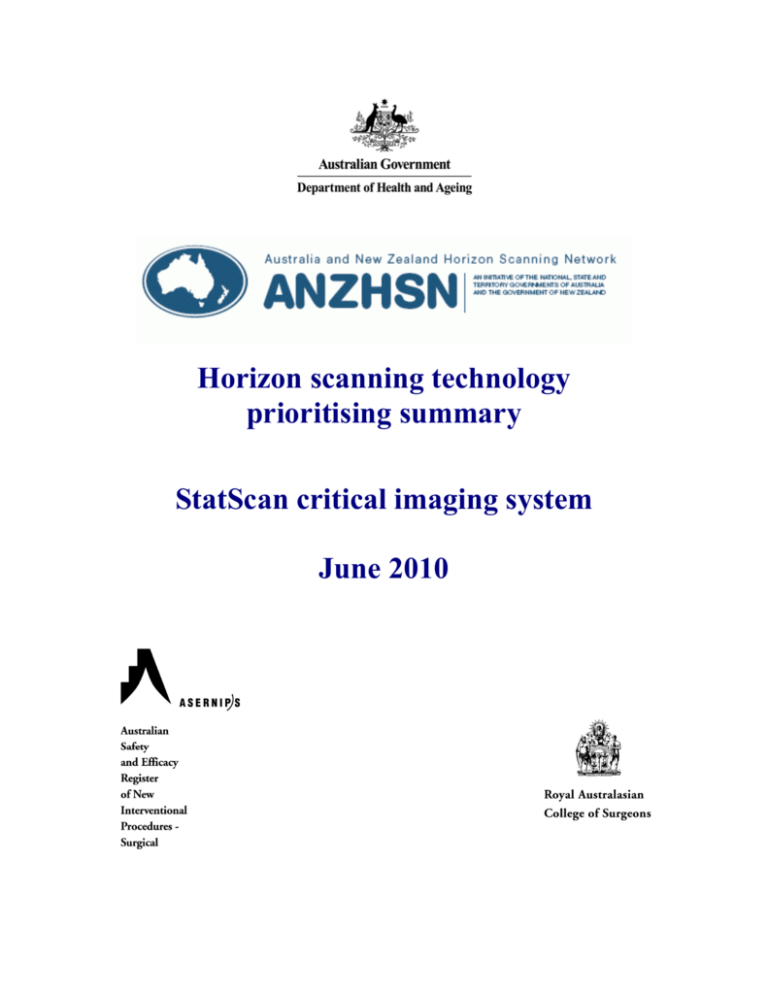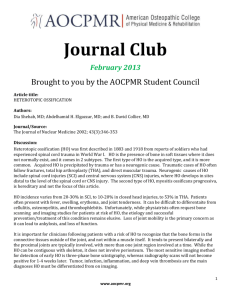
Horizon scanning technology
prioritising summary
StatScan critical imaging system
June 2010
© Commonwealth of Australia 2010
ISBN
Publications Approval Number:
This work is copyright. You may download, display, print and reproduce this material in
unaltered form only (retaining this notice) for your personal, non-commercial use or use within
your organisation. Apart from any use as permitted under the Copyright Act 1968, all other rights
are reserved. Requests and inquiries concerning reproduction and rights should be addressed to
Commonwealth Copyright Administration, Attorney General’s Department, Robert Garran
Offices, National Circuit, Canberra ACT 2600 or posted at http://www.ag.gov.au/cca
Electronic copies can be obtained from http://www.horizonscanning.gov.au
Enquiries about the content of the report should be directed to:
HealthPACT Secretariat
Department of Health and Ageing
MDP 106
GPO Box 9848
Canberra ACT 2606
AUSTRALIA
DISCLAIMER: This report is based on information available at the time of research cannot be
expected to cover any developments arising from subsequent improvements health technologies.
This report is based on a limited literature search and is not a definitive statement on the safety,
effectiveness or cost-effectiveness of the health technology covered.
The Commonwealth does not guarantee the accuracy, currency or completeness of the
information in this report. This report is not intended to be used as medical advice and intended to
be used to diagnose, treat, cure or prevent any disease, nor should it be used therapeutic purposes
or as a substitute for a health professional's advice. The Commonwealth does not accept any
liability for any injury, loss or damage incurred by use of or reliance the information.
The production of these Horizon scanning prioritising summaries was overseen by the Health
Policy Advisory Committee on Technology (HealthPACT). HealthPACT comprises
representatives from health departments in all states and territories, the Australia and New
Zealand governments; MSAC and ASERNIP-S. The Australian Health Ministers’ Advisory
Council (AHMAC) supports HealthPACT through funding.
This Horizon scanning prioritising summary was prepared by Deanne Leopardi from the
Australian Safety and Efficacy Register of New Interventional Procedures – Surgical (ASERNIPS).
PRIORITISING SUMMARY
NAME OF TECHNOLOGY
LODOX STATSCAN CRITICAL IMAGING SYSTEM
(REFERRAL)
PURPOSE AND TARGET GROUP
PROVIDE RAPID (13 SECONDS) WHOLE-BODY,
SKELETAL AND SOFT-TISSUE, LOW-DOSE X-RAY TO
TRAUMA PATIENTS
STAGE OF DEVELOPMENT (IN AUSTRALIA)
;
Yet to emerge
Experimental
Investigational
Nearly established
Established
Established but changed indication
or modification of technique
Should be taken out of use
AUSTRALIAN THERAPEUTIC GOODS ADMINISTRATION APPROVAL
;
Yes
No
Not applicable
ARTG number
NA
INTERNATIONAL UTILISATION
COUNTRY
Trials Underway
or Completed
LEVEL OF USE
Limited Use
South Africa
9
United States*
9
Sudan*
9
Switzerland
*8 machines in the United States and 2 machines in Sudan (Knobel et al 2006).
Widely Diffused
9
IMPACT SUMMARY
StatScan provides trauma doctors with critical information about a patient’s injuries so
that necessary treatment can be determined, potentially improving patient outcomes by
reducing the time between admission and access to treatment.
BACKGROUND
StatScan is a digital x-ray scanning system that can produce diagnostic, full-body x-ray
images in 13 seconds. StatScan appears to be particularly useful in trauma and emergency
patients because the patient can be easily accessed with minimal manoeuvre required, and
the full-body images it provides are capable of detecting multiple injuries, which are
StatScan Critical Imaging System
June 2010
1
often missed by conventional sized x-rays. In emergency medicine, the time period
following a traumatic injury being sustained during which there is the highest likelihood
that prompt medical treatment will prevent death is referred to as the ‘golden hour’, and
may actually last from a few minutes to several hours. The rapid acquisition of diagnostic
images achievable using StatScan allows trauma patients rapid access to specialised
treatment and in turn should improve their treatment and survival outcomes.
StatScan has a rotating anode x-ray tube mounted on one end of a C-arm which emits a
low-dose, collimated fan-beam of x-rays (Pitcher et al 2009). Fixed to the other end of the
C-arm is the x-ray detector unit (Evangelopoulos et al 2009) (Figure 1). The C-arm can
travel the length of the table at up to 138 mm per second (Evangelopoulos et al 2009).
StatScan captures anteroposterior images; however, whole-body, horizontal beam, shootthrough lateral, erect, and oblique views may also be taken (Evangelopoulos et al 2009).
The StatScan unit also includes an integrated docking resuscitation table to eliminate
transfer of the patient and allow complete patient access for resuscitation
(Evangelopoulos et al 2009). The images are immediately available via a personal
computer and may be enlarged for better viewing (Evangelopoulos et al 2009).
Figure 1: StatScan in the anteroposterior imaging position.
X-ray tube
Self-docking table
X-ray detector unit
(Image taken from www.Lodox.com)
Other uses for StatScan include forensic applications (such as locating bullets or foreign
bodies), bone cancer detection, urinary stone detection, and diagnosis of acute
ventriculoperitoneal shunt dysfunction. In particular, diagnosis of acute
ventriculoperitoneal shunt dysfunction traditionally requires serial two-dimensional
conventional radiographs of the skull and chest (and possibly the abdomen) and because
shunt malfunction may be a common complication, repeated radiation exposure may lead
to an increased risk of malignancies (Evangelopoulos et al 2009). StatScan purportedly
minimises this risk by achieving adequate imaging using a single, low-dose scan. The
majority of studies identified used StatScan in trauma patients, for this reason, this
summary focuses on this indication alone.
CLINICAL NEED AND BURDEN OF DISEASE
StatScan Critical Imaging System
June 2010
2
Comprehensive clinical and radiological evaluation of multiply injured patients is
challenging, consequently diagnostic error rates have been documented between 2.5%
and 20% (Pitcher et al 2009). Errors are primarily due to inadequate radiographic
practise, with missed fractures constituting the largest proportion (Pitcher et al 2009).
Imaging of a polytrauma patient is not only time consuming and technically difficult,
each radiographic exposure increases the dose of ionizing radiation the patient is exposed
to. The risk of cancer is increased with the radiation dose of each examination, and in the
tissues of children in particular, cellular infrastructure may be modified and predispose
them to malignant change later in life (Pitcher et al 2009). StatScan is a potential lowdose alternative to existing devices, therefore decreasing the risk associated with
diagnostic imaging in trauma patients.
The Australian Institute of Health and Welfare (AIHW) reported 2% of cancers were due
to radiation exposure (AIHW 2010).
DIFFUSION
ScatScan was developed by De Beers in South Africa for use in the diamond-mining
industry for theft surveillance, so that full-body scans could be taken of workers in order
to detect diamonds that may have been hidden in clothing or swallowed, at this time the
unit was known as Scannex (Knobel et al 2006). The motivation for its development was
the need for an imaging technique that used the lowest possible radiation level to provide
a good quality image, which was safe enough for daily use. In 1995, StatScan was
recognised for its diagnostic potential and subsequent research found it to provide similar
quality images to that of conventional radiographs, culminating in the United States Food
and Drug Administration (2002) and the European Union (2004) approving the unit for
radiographic examination of both trauma and standard emergency patients (Pitcher al
2009). About 25 trauma centres worldwide have incorporated StatScan into their
emergency management protocols (Evangelopoulos et al 2009).
StatScan is yet to emerge in Australia and consequently did not exist on the Australian
Register of Therapeutic Goods at the time of writing. Correspondence with the Australian
and New Zealand distributer of StatScan (ATX Medical Solutions) revealed they are
currently working with two hospitals in Australia in regards to the installation of a
StatScan unit; however, no units were in operation at these sites as yet.
COMPARATORS
The current gold standard in emergency department’s trauma imaging is CT scanning. It
is important to note that StatScan is not a CT scanner; therefore, should not be considered
a replacement. It is more likely that a combination of StatScan imaging, focused
abdominal sonography for trauma, and a thorough clinical examination may reduce the
number of CT scans taking place in an emergency setting.
The 7th edition of the ATLS Guidelines (2004) recommends three x-rays as part of the
primary patient survey (cervical spine, thorax, and pelvis) (Deyle et al 2009). These
images are obtained by bedside machines so they can only be acquired in one plane and
StatScan Critical Imaging System
June 2010
3
are therefore limited (Deyle et al 2009). Delays due to the positioning of the portable xray system, high direct and scattering radiation, and practical difficulties in acquiring
satisfactory images can adversely affect patient management, morbidity, and mortality
(Deyle et al 2009). Conventional x-rays can also be considered a comparator for wholebody, low-dose x-ray StatScan.
SAFETY AND EFFECTIVENESS ISSUES
A total of four comparative studies were identified for inclusion in this summary (Deyle
et al 2010; Deyle et al 2009; Exadaktylos et al 2008; Beningfield et al 1999). All of these
studies looked at the use of StatScan in trauma patients and compared its diagnostic
efficacy with that of conventional imaging techniques. The two studies by Deyle et al
(2009 and 2010) report outcomes in the same patient population and are therefore
reported as a single study below.
In the studies by Deyle et al a retrospective chart analysis of a total of 245 consecutive
polytrauma patients, aged 16 years or older, was undertaken. Each patient underwent
StatScan imaging followed by full-body CT scanning. Where possible, the following
diagnoses were compared between StatScan and CT images, chest injuries with
pneumothorax, signs of lung contusion, mediastinal injuries (rupture of the aorta or
pneumomediastinum), thoracic skeletal lesions (fractures of the ribs and clavicles), or
peripheral bone fractures. Of the 245 patients, 172 were men and 73 women. The most
common causes of injury were motor vehicle crash (60%), falls from height (20%), and
pedestrians hit by motor vehicles (10%). Mean Injury Severity Score (ISS) 1 was 20
(range: 16-86 2 ).
Exadaktylos et al (2008) reported the use of StatScan in 143 consecutive trauma patients
between October 2006 and February 2007 and compared their outcomes with those of
650 patients treated between January 2002 and January 2004 with conventional ATLS
protocol (conventional x-ray). Mean ISS in the treatment group was 15 ± 14 (range: 3-75)
and mean ISS in the control group was 14 ± 14 (range: 3-75).
The study by Beningfield et al (1999) describes an initial experience of using the lowdose, full-body x-ray security system (Scannex) for diagnostic purposes before the unit
was redesigned and marketed for medical use as StatScan. Detailed image quality testing
and radiation dose measurement using standard medical physics equipment and
techniques were undertaken. A total of 65 trauma, medical and paediatric patients were
evaluated; 32.3% (21/65) of patients had gunshot wounds, 21.5% (14/65) had stab
wounds, 20% (13/65) were involved in a motor vehicle accident, 4.6% (3/65) suffered a
fall, 3.1% (2/65) had a blunt injury, and 18.5% (12/65) had another condition. The mean
age of the patients was 36 years (range: 0-86 years).
1
Injury Severity Score takes values from 0 to 75. The Injury Severity Score is the only anatomical
scoring system in use and correlates linearly with mortality, morbidity, hospital stay and other
measures of severity (Baker et al 1974).
2
It is unclear why the ISS upper range is greater than 75 in this case.
StatScan Critical Imaging System
June 2010
4
Safety and Effectiveness
Deyle et al (2009) reported the efficacy of detecting chest, thoracolumbar spine and
pelvis injuries using CT scan and ScatScan images. Table 1 below summaries the results
obtained.
Table 1: Chest, thoracolumbar spine and pelvis injuries detected by CT versus StatScan.
Number of patients (%)
CT scan
StatScan
Injury
Chest
Pneumothorax
Lung contusion
Mediastinal injuries
Fractured ribs and clavicles
Multiple rib fractures
Thoracolumbar spine
Thoracic spine fractures
Vertebral body and spinous fractures
Lumbar spine lesions
Pelvis
Pelvic injuries
Stable injuries
Pelvic fractures
Rotationally and vertically unstable lesions
Sensitivity
54/245 (22%)*
60/245 (24%)
13/245 (5%)
85/245 (35%)
50/245 (20%)
26/49 (54%)
27/60 (45%)
7/13 (54%)
62/85 (73%)
43/50 (86%)
54%
45%
54%
73%
86%
44/245 (18%)
35/245 (14%)
54/245 (22%)
19/44 (43%)
18/35 (51%)
40/54 (74%)
43%
51%
74%
41/245 (17%)
16/41 (39%)
17/41 (41%)
8/41 (20%)
28/245 (11%)
9/16 (56%)
12/17 (71%)
7/8 (88%)
11%
56%
71%
88%
*Five patients excluded because tubes in situ.
Additional sensitivity and specificity results reported in the later study by Deyle et al
(2010) for peripheral bone injuries are presented below in Table 2.
Table 2: Sensitivity and specificity of StatScan in detecting peripheral bone injuries.
Sensitivity
Limbs (excluding hands and feet)
Shoulder lesions
Distal humerus fractures
Forearm fractures
Femoral fractures
Tibia/fibia fractures
Hand and feet
Hand fractures
Foot fractures
Overall excluding hands and feet
Overall including hands and feet
Specificity
72%
90%
64%
88%
80%
100%
100%
100%
100%
100%
55%
45%
81%
73%
100%
100%
100%
100%
The results reported in the studies by Deyle et al (2009 and 2010) indicate the sensitivity
of StatScan to be 45-86% for detecting chest injuries, 43-74% for detecting
StatScan Critical Imaging System
June 2010
5
thoracolumbar spine injuries, 11-88% for detecting pelvis injuries, 64-90% for detecting
limb injuries (excluding hands and feet), and 55% and 45% for detecting hand and foot
injuries, respectively. Based on these results, StatScan does not appear to be as effective
as CT scanning in detecting several types of injuries.
Exadaktylos et al (2008) reported a total-body scanning time of 3.5 minutes (range: 3-6
minutes) for StatScan compared with 25.7 minutes (range: 8-48 minutes) for
conventional x-rays. The total emergency room time for both groups of patients (those
undergoing StatScan images and those undergoing conventional plain radiography) was
similar (28.7 minutes; range: 13-58 minutes versus 29.1 minutes; 15-65 minutes). Of the
143 patients undergoing StatScan images, 81% (116/143) required additional CT scans,
and in 84% (98/116) of these, full body trauma CT scans were necessary. Fifteen percent
(18/116) of patients required selective CT scans based on StatScan findings and 30%
(43/143) of patients had additional x-rays performed, mainly due to inadequate
anteroposterior views of fractured bones.
Finally, the study by Beningfield et al (1999) measured radiation dose in addition to
assessing image quality. Overall radiation dose was very low, both in the direct beam and
from scattered radiation. The mean entrance surface dose to the patient was 6.2 microSieverts, which was approximately 3% (range: 0.3-13%) of the conventional radiation
dose. The same reduction in radiation dose (3%) was noted for staff standing adjacent to
the modified Scannex unit compared with conventional x-ray machines.
On a case-by-case basis, in regards to image quality, modified Scannex performed as well
as conventional radiography in 40.6% (26/64) of cases, and in one case (1.6%) modified
Scannex was superior to conventional radiography. Digital performance was equal to that
of conventional radiographs in 42.9% (67/156) of specific pathological features, and in
12.8% (20/156) it provided additional information compared with conventional
radiographs. Table 3 below describes this in greater detail.
Table 3: Specific radiographic features detected by modified Scannex versus conventional
x-ray.
Specific feature
Patients
Fractures
Rib fractures
Skull fractures
Pneumothorax
Haemothorax
Pneumomediastinum
Surgical emphysema
Extraluminal air
Opacification
Bullae
Other
Total
Conventional x-ray
64
41
13
2
18
7
3
16
2
24
6
55
156
StatScan Critical Imaging System
June 2010
Modified Scannex
26
13
5
0
11
7
2
11
1
13
0
18
67
Sensitivity
40.6%
31.7%
38.5%
0%
61.1%
100%
66.7%
68.8%
50%
54.2%
0%
32.7%
42.9%
6
None of the included studies reported complications that occurred in association with the
StatScan imaging procedure (Deyle et al 2009; Deyle et al 2010; Exadaktylos et al 2008;
Beningfield et al 1999).
COST IMPACT
The acquisition costs of StatScan are similar to those for conventional hospital imaging
products (Evangelopoulos et al 2009). Material and running costs are appear to be low
because the device operates with compatible digital computerised software using
conventional computer hardware. One study reported no additional costs in regards to
staff time or service costs (Evangelopoulos et al 2009).
ATX Medical Solutions provided a budgetary price for a StatScan system, at $550,000
excluding GST.
ETHICAL, CULTURAL OR RELIGIOUS CONSIDERATIONS
There were no issues identified from the retrieved material.
OTHER ISSUES
One study reported that both radiographic and medical staff found modified Scannex easy
to use after approximately 30 minutes of tuition. Image retrieval and manipulation
through personal computer software was subjectively rated as satisfactory by the users,
although the user interface was felt to require simplification (Beningfield et al 1999). It is
likely during the redesign of the unit the user interface has been updated.
SUMMARY OF FINDINGS
From the literature StatScan appears to offer an improvement in time management when
treating trauma patients and effectively reduces radiation exposure to patients and their
carers. However, at this stage, StatScan appears to be less sensitive in detecting injuries in
trauma and emergency patients compared with conventional radiographic techniques
(including CT scanning and x-ray imaging) in many cases; therefore, based on these
findings StatScan may be suitable for use adjunct to conventional imaging and
examination, instead of as a single diagnostic modality.
HEALTHPACT ASSESSMENT
StatScan appears to have the potential for rapid diagnosis of traumatic injuries, however
the technology requires further refinement and development before it can be utilised
effectively within a clinical setting. HealthPACT has noted this technology but no further
assessment by HealthPACT is necessary at this time.
NUMBER OF STUDIES INCLUDED
Total number of studies
Level III-2 evidence
Level III-3 evidence
4
2
2
StatScan Critical Imaging System
June 2010
7
REFERENCES
Australian Institute of Health and Welfare. Profile of cancer. Last Updated 1997.
http://www.aihw.gov.au/publications/phe/nhpacc97/nhpacc97-c01.pdf [Accessed May
2010].
Baker SP, O’Neill B, Haddon W, Long WB. The Injury Severity Score: a method for
describing patients with multiple injuries and evaluating emergency care. The Journal of
Trauma 1974; 14(3):187-196.
Beningfield SJ, Potgieter JH, Bautz P, Shackleton M, Hering E, de Jager G, Bowie G,
Marshall M, Cox G, Pagliari G, Coetzee N. Evaluation of a new type of direct digital
radiography machine. South African Medical Journal 1999; 89(11): 1182-1188.
Deyle S, Wagner A, Benneker LM, Jeger V, Eggli S, Bonel HM, Zimmermann H,
Exadaktylos AK. Could full-body digital X-ray (LODOX-Statscan) screening in trauma
challenge conventional radiography? J Trauma 2009; 66(2): 418-422.
Deyle S, Brehmer T, Evangelopoulos DS, Krause F, Benneker LM, Zimmermann H,
Exadakylos AK. Review of Lodox Statscan in the detection of peripheral skeletal
fractures in multiple injury patients. Injury (2010), doi: 10.1016/j.injury.2010.03.
021.
Evangelopoulos DS, Deyle S, Zimmermann H, Exadaktylos AK. Personal experience
with whole-body, low-dosage, digital X-ray scanning (LODOX-Statscan) in trauma.
Scand J Trauma Resusc.Emerg Med 2009; 17(1): 41.
Exadaktylos AK, Benneker LM, Jeger V, Martinolli L, Bonel HM, Eggli S, Potgieter H,
Zimmermann H. Total-body digital X-ray in trauma. An experience report on the first
operational full body scanner in Europe and its possible role in ATLS. Injury 2008; 39(5):
525-529.
Knobel GJ, Flash G, Bowie GF. Lodox Statscan proves to be invaluable in forensic
medicine. S Afr Med J 2006; 96(7): 593-4, 596.
Lodox Critical Imaging Technology. Imaging products: technical specs for StatScan. Last
Updated 2010. http://www.lodox.com/technical.html [Accessed May 2010].
Pitcher RD, Wilde JC, Douglas TS, van As AB. The use of the Statscan digital X-ray unit
in paediatric polytrauma. Pediatr Radiol 2009; 39(5): 433-437.
SOURCES OF FURTHER INFORMATION
Boffard KD, Goosen J, Plani F, Degiannis E, Potgieter H. The use of low dosage X-ray
(Lodox/Statscan) in major trauma: comparison between low dose X-ray and conventional
x-ray techniques. J Trauma 2006; 60(6): 1175-1181.
StatScan Critical Imaging System
June 2010
8
Mulligan M, Smith S, Talmi D. Whole body radiography for bone survey screening of
cancer and myeloma patients. Cancer Invest 2008; 26(9): 916-922.
Mulligan ME and Flye CW. Initial experience with Lodox Statscan imaging system for
detecting injuries of the pelvis and appendicular skeleton. Emerg Radiol 2006; 13(3):
129-133.
Pitcher RD, van As AB, Sanders V, Douglas TS, Wieselthaler N, Vlok A, Paverd S,
Kilborn T, Rode H, Potgieter H, Beningfield SJ. A pilot study evaluating the
"STATSCAN" digital X-ray machine in paediatric polytrauma. Emerg Radiol 2008;
15(1): 35-42.
SEARCH CRITERIA TO BE USED
StatScan OR Lodox StatScan
Low-dose AND digital xray
Critical imaging system
HEALTH PACT DECISION
Horizon Scanning Report
Monitor
Refer
Full Health Technology Assessment
Archive
Decision pending
PRIORITY RATING
High
StatScan Critical Imaging System
June 2010
Medium
Low
9





![Physics of Radiologic Imaging [Opens in New Window]](http://s3.studylib.net/store/data/008568907_1-1e7d7b82bfd2882a3a695d3f7c130835-300x300.png)

